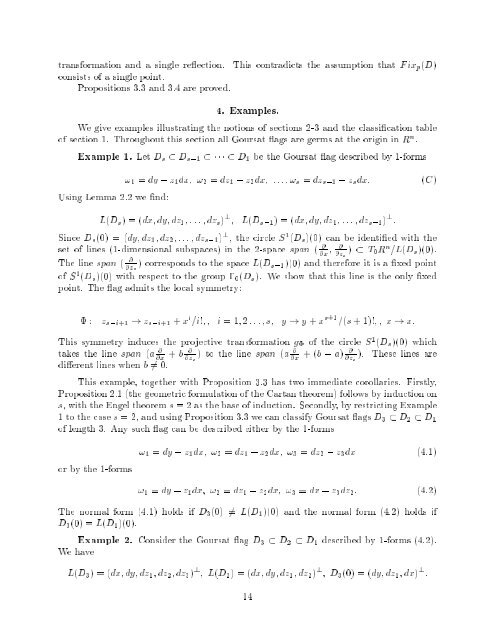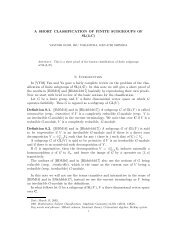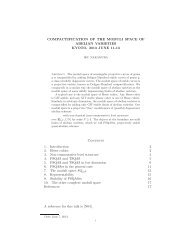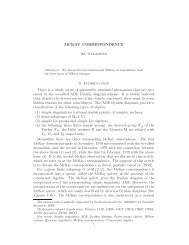GEOMETRIC APPROACH TO GOURSAT FLAGS * Richard ...
GEOMETRIC APPROACH TO GOURSAT FLAGS * Richard ...
GEOMETRIC APPROACH TO GOURSAT FLAGS * Richard ...
- No tags were found...
You also want an ePaper? Increase the reach of your titles
YUMPU automatically turns print PDFs into web optimized ePapers that Google loves.
transformation and a single reection. This contradicts the assumption that Fix p (D)consists of a single point.Propositions 3.3 and 3.4 are proved.4. Examples.We give examples illustrating the notions of sections 2-3 and the classication tableof section 1. Throughout this section all Goursat ags are germs at the origin in R n .Example 1. Let D s D s;1 D 1 be the Goursat ag described by 1-formsUsing Lemma 2.2 we nd:! 1 = dy ; z 1 dx ! 2 = dz 1 ; z 2 dx :::! s = dz s;1 ; z s dx: (C)L(D s )=(dx dy dz 1 :::dz s ) ? L(D s;1 )=(dx dy dz 1 :::dz s;1 ) ? :Since D s (0) = (dy dz 1 dz 2 :::dz s;1 ) ? , the circle S 1 (D s )(0) can be identied with theset of lines (1-dimensional subspaces) in the 2-space span ( @ @@x @z s) T 0 R n =L(D s )(0):The line span ( @@z s) corresponds to the space L(D s;1 )(0) and therefore it is a xed pointof S 1 (D s )(0) with respect to the group ; 0 (D s ). We show that this line is the only xedpoint. The ag admits the local symmetry:: z s;i+1 ! z s;i+1 + x i =i! i =1 2 :::s y ! y + x s+1 =(s + 1)! x! x:This symmetry induces the projective transformation g of the circle S 1 (D s )(0) whichtakes the line span (a @ + b @@x @z s)tothe line span (a @@+(b ; a)@x @z s). These lines aredierent lines when b 6= 0.This example, together with Proposition 3.3 has two immediate corollaries. Firstly,Proposition 2.1 (the geometric formulation of the Cartan theorem) follows by induction ons, with the Engel theorem s =2asthe base of induction. Secondly, byrestricting Example1tothe case s =2,and using Proposition 3.3 we can classify Goursat ags D 3 D 2 D 1of length 3. Any such ag can be described either by the1-formsor by the 1-forms! 1 = dy ; z 1 dx ! 2 = dz 1 ; z 2 dx ! 3 = dz 2 ; z 3 dx (4:1)! 1 = dy ; z 1 dx ! 2 = dz 1 ; z 2 dx ! 3 = dx ; z 3 dz 2 : (4:2)The normal form (4.1) holds if D 3 (0) 6= L(D 1 )(0) and the normal form (4.2) holds ifD 3 (0) = L(D 1 )(0).Example 2. Consider the Goursat ag D 3 D 2 D 1 described by 1-forms (4.2).We haveL(D 3 )=(dx dy dz 1 dz 2 dz 3 ) ? L(D 2 )=(dx dy dz 1 dz 2 ) ? D 3 (0) = (dy dz 1 dx) ? :14





